Upgrade
On this page, you find all documents, package deals, and flashcards offered by seller upgrade.
- 231
- 0
- 19
Community
- Followers
- Following
250 items
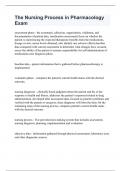
The Nursing Process in Pharmacology Exam
assessment phase - the systematic collection, organization, validation, and documentation of patient data, (medication assessment) focus on whether the patient is experiencing the expected therapeutic benefits from the medications, dosage review, serum levels obtained, also identify any adverse effects,baseline data compared with current assessment to determine what changes have occured, assess the ability of the patient to assume responsibility for self-administration of medications-next diagno...
- Exam (elaborations)
- • 10 pages •
assessment phase - the systematic collection, organization, validation, and documentation of patient data, (medication assessment) focus on whether the patient is experiencing the expected therapeutic benefits from the medications, dosage review, serum levels obtained, also identify any adverse effects,baseline data compared with current assessment to determine what changes have occured, assess the ability of the patient to assume responsibility for self-administration of medications-next diagno...

BMD 410 Exam Questions and Answers graded A
What are the 3 majors stages of cellular respiration - Acetyl CoA production Acetyl CoA oxidation Electron transfer and oxidative phosphorylation What is the Acetyl CoA production process shared by? - Amino Acids, Fatty acids, and glucose can all be used to create acetyl CoA What generally occurs in stage 2, acetyl-CoA oxidation? - Creates electron carriers NADH, FADH2 and GTP or ATP; reoxidizing our electron carriers by reducing them Where does glycolysis occur? - cytoplasm Wh...
- Package deal
- Exam (elaborations)
- • 18 pages •
What are the 3 majors stages of cellular respiration - Acetyl CoA production Acetyl CoA oxidation Electron transfer and oxidative phosphorylation What is the Acetyl CoA production process shared by? - Amino Acids, Fatty acids, and glucose can all be used to create acetyl CoA What generally occurs in stage 2, acetyl-CoA oxidation? - Creates electron carriers NADH, FADH2 and GTP or ATP; reoxidizing our electron carriers by reducing them Where does glycolysis occur? - cytoplasm Wh...
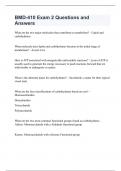
BMD-410 Exam 2 Questions and Answers
What are the two major molecules that contribute to metabolism? - Lipids and carbohydrates What molecule does lipids and carbohydrates become in the initial stage of metabolism? - Acetyl CoA How is ATP associated with energetically unfavorable reactions? - Lysis of ATP is usually used to generate the energy necessary to push reactions forward that are unfavorable or endergonic in nature. What is the alternate name for carbohydrates? - Saccharide, a name for their typical sweet taste ...
- Package deal
- Exam (elaborations)
- • 30 pages •
What are the two major molecules that contribute to metabolism? - Lipids and carbohydrates What molecule does lipids and carbohydrates become in the initial stage of metabolism? - Acetyl CoA How is ATP associated with energetically unfavorable reactions? - Lysis of ATP is usually used to generate the energy necessary to push reactions forward that are unfavorable or endergonic in nature. What is the alternate name for carbohydrates? - Saccharide, a name for their typical sweet taste ...
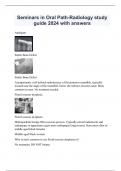
Seminars in Oral Path-Radiology study guide 2024 with answers
Amalgam Stafne Bone Defect Stafne Bone Defect Asymptomatic well defined radiolucency of the posterior mandible, typically located near the angle of the mandible, below the inferior alveolar canal. More common in men. No treatment needed Florid osseous dysplasia Florid osseous dysplasia Multiquadrant benign fibro-osseous process. Typically mixed radiolucent and radiopaque in appearance (gets more radiopaque longer term). Seen most often in middle aged black females Middle aged bla...
- Exam (elaborations)
- • 18 pages •
Amalgam Stafne Bone Defect Stafne Bone Defect Asymptomatic well defined radiolucency of the posterior mandible, typically located near the angle of the mandible, below the inferior alveolar canal. More common in men. No treatment needed Florid osseous dysplasia Florid osseous dysplasia Multiquadrant benign fibro-osseous process. Typically mixed radiolucent and radiopaque in appearance (gets more radiopaque longer term). Seen most often in middle aged black females Middle aged bla...
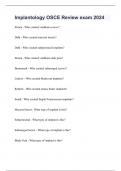
Implantology OSCE Review exam 2024
Strock - Who created vitallium screws? Dahl - Who created mucosal inserts? Dahl - Who created subperiosteal implants? Strock - Who created vitallium endo pins? Branemark - Who created submerged screws? Linkow - Who created bladevent implants? Roberts - Who created ramus frame implants? Small - Who created Staple/Transosseous implants? Mucosal Insert - What type of implant is this? Subperiosteal - What type of implant is this? Submerged Screw - What type of implant i...
- Exam (elaborations)
- • 13 pages •
Strock - Who created vitallium screws? Dahl - Who created mucosal inserts? Dahl - Who created subperiosteal implants? Strock - Who created vitallium endo pins? Branemark - Who created submerged screws? Linkow - Who created bladevent implants? Roberts - Who created ramus frame implants? Small - Who created Staple/Transosseous implants? Mucosal Insert - What type of implant is this? Subperiosteal - What type of implant is this? Submerged Screw - What type of implant i...
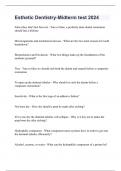
Esthetic Dentistry-Midterm test 2024
False (they don't last forever) - True or false, a perfectly done dental restoration should last a lifetime Microorganisms and mechanical stresses - What are the two main reasons for tooth breakdown? Biomechanics and Occlusion - What two things make up the foundations of the aesthetic pyramid? True - True or false we should etch both the dentin and enamel before a composite restoration To open up the dentinal tubules - Why should we etch the dentin before a composite restoration? ...
- Exam (elaborations)
- • 10 pages •
False (they don't last forever) - True or false, a perfectly done dental restoration should last a lifetime Microorganisms and mechanical stresses - What are the two main reasons for tooth breakdown? Biomechanics and Occlusion - What two things make up the foundations of the aesthetic pyramid? True - True or false we should etch both the dentin and enamel before a composite restoration To open up the dentinal tubules - Why should we etch the dentin before a composite restoration? ...
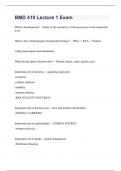
BMD 410 Lecture 1 Exam
What is biochemistry? - Study or the chemistry of life processses at the molecular level What is the central dogma of molecular biology? - DNA -> RNA -> Protein Using transcription and translation What are the major biomolecules? - Protein, lipids, carbs, nucleic acid Important role of proteins - -signaling molecules -receptors -cellular structure -mobility -immune defense -BIOCATALYST (ENZYMES)
- Package deal
- Exam (elaborations)
- • 3 pages •
What is biochemistry? - Study or the chemistry of life processses at the molecular level What is the central dogma of molecular biology? - DNA -> RNA -> Protein Using transcription and translation What are the major biomolecules? - Protein, lipids, carbs, nucleic acid Important role of proteins - -signaling molecules -receptors -cellular structure -mobility -immune defense -BIOCATALYST (ENZYMES)

BMD 410 Lecture 2 exam guide 2024
Which bonds are important in biology? - Permanent bonds-covalent for backbones Transient bonds-hydrogen for structural changes What is the difference between covalent and non-covalent interactions? - Covalent bonds share electrons while noncovalent bonds don't share of electrons What are hydrophobic interactions? - Association or interactions of nonpolar molecules or components of molecules in aqueous solution -main driving force of -protein folding -protein protein interactions ...
- Package deal
- Exam (elaborations)
- • 3 pages •
Which bonds are important in biology? - Permanent bonds-covalent for backbones Transient bonds-hydrogen for structural changes What is the difference between covalent and non-covalent interactions? - Covalent bonds share electrons while noncovalent bonds don't share of electrons What are hydrophobic interactions? - Association or interactions of nonpolar molecules or components of molecules in aqueous solution -main driving force of -protein folding -protein protein interactions ...
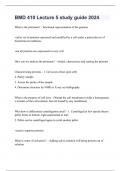
BMD 410 Lecture 5 study guide 2024
What is the proteome? - functional representation of the genome -entire set of proteins expressed and modified by a cell under a particular set of biochemical conditions. -not all proteins are expressed in every cell How can we analyze the proteome? - Isolate, characterize and catalog the proteins Characterizing proteins - 1. Get access (bust open cell) 2. Purify sample 3. Assess the purity of the sample 4. Determine structure by NMR or X-ray crystallography What is the purpose...
- Package deal
- Exam (elaborations)
- • 6 pages •
What is the proteome? - functional representation of the genome -entire set of proteins expressed and modified by a cell under a particular set of biochemical conditions. -not all proteins are expressed in every cell How can we analyze the proteome? - Isolate, characterize and catalog the proteins Characterizing proteins - 1. Get access (bust open cell) 2. Purify sample 3. Assess the purity of the sample 4. Determine structure by NMR or X-ray crystallography What is the purpose...
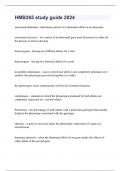
HMB265 study guide 2024
autosomal dominant - inheritance pattern of a dominant allele on an autosome autosomal recessive - two copies of an abnormal gene must be present in order for the disease or trait to develop heterozygous - having two different alleles for a trait homozygous - having two identical alleles for a trait incomplete dominance - case in which one allele is not completely dominant over another, the phenotypes get mixed together (ex: pink) the phenotypes varies continuously with levels of ...
- Exam (elaborations)
- • 27 pages •
autosomal dominant - inheritance pattern of a dominant allele on an autosome autosomal recessive - two copies of an abnormal gene must be present in order for the disease or trait to develop heterozygous - having two different alleles for a trait homozygous - having two identical alleles for a trait incomplete dominance - case in which one allele is not completely dominant over another, the phenotypes get mixed together (ex: pink) the phenotypes varies continuously with levels of ...
